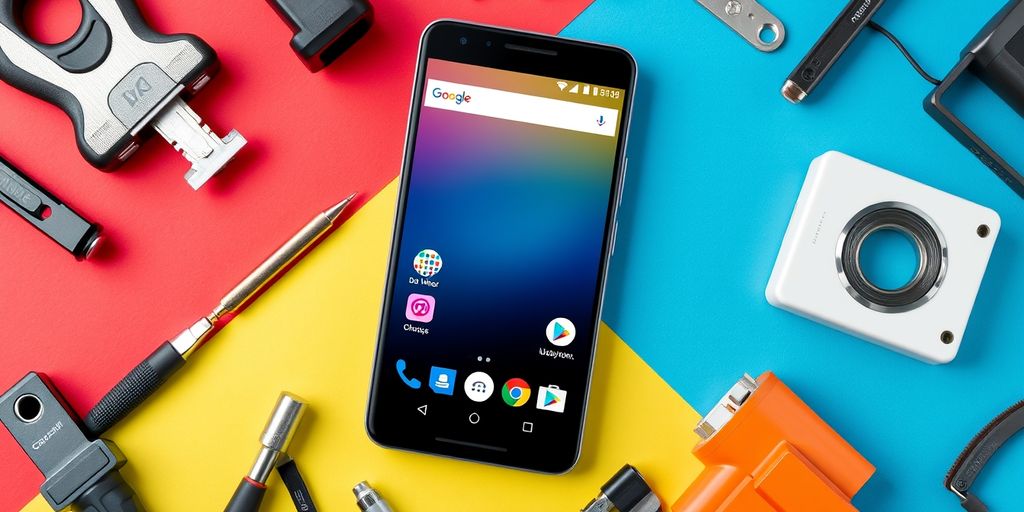Building your own custom Android phone can be an exciting and rewarding project. It allows you to personalize your device to fit your needs and preferences. This guide will walk you through the basics of what a custom Android phone is, the components you'll need, and the steps to create one. Whether you're a beginner or have some experience, this guide will help you every step of the way.
Key Takeaways
- A custom Android phone is tailored to your specific needs and preferences.
- You can choose the hardware and software that best suits your usage.
- Installing custom ROMs can improve your device's performance and features.
- Understanding compatibility between parts is crucial for a successful build.
- Regular maintenance and updates are essential to keep your custom phone running smoothly.
Understanding the Concept of a Custom Android Phone
Defining Custom Android Phones
A custom Android phone is a device that has been modified to suit the specific needs and preferences of the user. This can include changes to the hardware, software, or both. These modifications allow users to personalize their devices beyond the standard options provided by manufacturers.
Benefits of Customization
Customizing your Android phone offers several advantages:
- Enhanced Performance: Users can optimize their devices for better speed and efficiency.
- Unique Features: Custom ROMs can introduce new functionalities that are not available in stock versions.
- Improved User Experience: Tailoring the interface can make the device more user-friendly.
Common Misconceptions
Many people have misconceptions about custom Android phones. Here are a few:
- Customization voids warranty: While some modifications can void warranties, not all do.
- It's too complicated: With the right guides, many users can successfully customize their devices.
- Custom ROMs are unsafe: While there are risks, many custom ROMs are well-tested and secure.
Custom Android phones can breathe new life into older devices, making them feel fresh and new again.
In summary, understanding the concept of a custom Android phone involves recognizing its definition, benefits, and addressing common misconceptions. As technology evolves, especially with updates like what’s new in Android 15, the possibilities for customization continue to expand, offering users even more ways to enhance their devices.
Essential Components for Building a Custom Android Phone
Creating a custom Android phone involves several key components that are essential for a successful build. Understanding these components is crucial to ensure compatibility and functionality.
Choosing the Right Hardware
When selecting hardware for your custom Android phone, consider the following:
- Processor: Choose a powerful processor to handle tasks efficiently.
- RAM: More RAM allows for better multitasking.
- Storage: Ensure adequate storage for apps and data.
- Display: Select a display that meets your visual preferences.
- Battery: A larger battery capacity will enhance usage time.
Selecting the Operating System
The operating system is the backbone of your custom Android phone. You can choose from:
- Stock Android: Offers a clean experience without bloatware.
- Custom ROMs: These can provide additional features and customization options.
Understanding Compatibility Issues
Compatibility is a major concern when building a custom Android phone. Here are some common issues:
- Hardware Drivers: Ensure that drivers are available for your chosen hardware.
- Software Support: Check if the operating system supports your hardware configuration.
- Updates: Consider how updates will be managed for both software and hardware.
Building a custom Android phone requires careful planning and consideration of all components to ensure a smooth experience.
In summary, the essential components for building a custom Android phone include selecting the right hardware, choosing an appropriate operating system, and understanding potential compatibility issues. By focusing on these areas, you can create a device that meets your specific needs and preferences. Remember, android offers a sophisticated and powerful componentized model for building your ui, based on the fundamental layout classes: view and viewgroup.
Step-by-Step Process to Create Your Custom Android Phone
Creating your own custom Android phone can be an exciting project. Here’s a structured approach to guide you through the process.
Preparing Your Development Environment
- Connect your Android device to your computer using a USB cable. You can use the charger that came with your phone.
- Open the Platform-tools folder, which is created when you extract the necessary files.
- Enable USB debugging on your Android device by going to Settings > About phone and tapping the Build Number seven times to unlock Developer Options.
- In Developer Options, enable OEM unlocking if available.
Building the Software
- Download a custom ROM that suits your device. Popular options include LineageOS and Pixel Experience.
- Install a custom recovery tool like TWRP on your device. This will allow you to install the custom ROM.
- Boot your phone into recovery mode and back up your current system to avoid data loss.
- Install the custom ROM and any additional packages like GApps (Google Apps).
Testing and Debugging
- After installation, reboot your device and check if everything is functioning correctly.
- If you encounter issues, you may need to go back into recovery mode to troubleshoot or reinstall the ROM.
Remember: Customizing your Android phone can void your warranty. Always proceed with caution and ensure you have backups of your data.
By following these steps, you can successfully create your own custom Android phone, tailored to your preferences and needs. Enjoy the process and the unique experience it brings!
Exploring Custom ROMs for Enhanced Functionality
Popular Custom ROM Options
Custom ROMs are modified versions of the Android operating system that can enhance your device's performance and features. Some popular options include:
- LineageOS: Known for its stability and regular updates.
- Pixel Experience: Offers a stock Android experience similar to Google Pixel devices.
- Paranoid Android: Focuses on user interface customization and privacy features.
How to Install a Custom ROM
Installing a custom ROM can breathe new life into your device. Here’s a simplified process:
- Backup your data: Always start by backing up your important files.
- Unlock the bootloader: This step is crucial for installing a custom ROM.
- Install a custom recovery: Tools like TWRP allow you to flash the ROM.
- Download the ROM: Ensure it’s compatible with your device model.
- Flash the ROM: Use the custom recovery to install the ROM.
Advantages of Using Custom ROMs
Using a custom ROM can provide several benefits:
- Improved performance: Many ROMs are optimized for speed and efficiency.
- Extra features: Custom ROMs often include features not available in stock Android.
- Regular updates: Some ROMs receive updates more frequently than the original manufacturer.
Custom ROMs can significantly enhance your device's functionality, but they come with risks, such as voiding your warranty. Always proceed with caution.
In summary, the number of available custom ROMs for your device can vary greatly. For instance, popular devices like the Samsung Galaxy A14 5G have numerous options, while less popular models may have only a few or none at all. Always check the compatibility of the ROM with your specific device model before proceeding with installation. Finding the right ROM can transform your Android experience, making it more tailored to your needs.
Advanced Customization Techniques for Android Phones
Modifying User Interfaces
Customizing the user interface (UI) of your Android phone can significantly enhance your experience. You can change themes, icons, and even the layout of your home screen. Using third-party launchers like Nova Launcher or Action Launcher allows you to personalize your phone's appearance easily. Here are some popular customization options:
- Change app icons
- Adjust grid size on the home screen
- Add widgets for quick access to information
Integrating Unique Features
Adding unique features can make your Android phone stand out. You can integrate functionalities such as:
- Custom notification settings to prioritize important contacts. This allows you to customize message notifications so that some contacts are more prominent, ensuring you never miss an important message.
- Gesture controls for quick actions.
- Enhanced security features like face unlock or fingerprint scanning.
Performance Optimization Strategies
To ensure your custom Android phone runs smoothly, consider these optimization strategies:
- Regularly clear cache to free up space.
- Use performance-enhancing apps to manage background processes.
- Overclock your CPU for better performance, but be cautious as this can lead to overheating.
Remember, while customization can enhance your device, it’s essential to back up your data regularly to avoid losing important information during modifications.
Maintaining and Updating Your Custom Android Phone
Regular Software Updates
Keeping your custom Android phone updated is crucial for security and performance. Regular updates can help fix bugs and improve functionality. Here are some steps to ensure your device stays current:
- Check for updates regularly in the settings.
- Enable automatic updates if available.
- Manually download updates from trusted sources if necessary.
Backup and Recovery Solutions
Before making any major changes, it’s essential to back up your data. This ensures that you can recover your information if something goes wrong. Here’s how to back up your custom Android phone:
- Use built-in backup options in the settings.
- Consider third-party apps for more comprehensive backups.
- Store backups in multiple locations, such as cloud storage and external drives.
Troubleshooting Common Issues
Even with the best setups, issues can arise. Here are some common problems and their solutions:
- Device not booting: Try booting into recovery mode and performing a factory reset.
- App crashes: Clear the app cache or reinstall the app.
- Slow performance: Uninstall unused apps and clear storage space.
Maintaining your custom Android phone is not just about updates; it’s about ensuring a smooth and secure user experience. Regular maintenance can extend the life of your device and enhance its performance.
By following these guidelines, you can keep your custom Android phone running smoothly and efficiently. Remember, staying proactive is key to a successful custom Android experience!
Legal and Warranty Considerations in Custom Android Development
Understanding Device Warranty Implications
When you decide to build a custom Android phone, it is crucial to understand that unlocking the bootloader can void your device's warranty. This means that if something goes wrong with your phone, the manufacturer may refuse to repair it. Always check your manufacturer's policy regarding warranty before proceeding with any modifications.
Navigating Legal Restrictions
In addition to warranty issues, there are legal considerations to keep in mind. Some regions have laws that restrict the modification of devices. For example, certain software licenses may prohibit the redistribution of modified software. It is essential to familiarize yourself with these laws to avoid potential legal troubles.
Best Practices for Compliance
To ensure compliance with legal and warranty considerations, follow these best practices:
- Research your device's warranty: Understand what modifications are allowed.
- Read software licenses: Make sure you are not violating any terms.
- Keep backups: Always back up your data before making changes.
- Use trusted sources: Download software and ROMs from reputable sites to avoid malware.
Remember, while customizing your Android phone can be exciting, it is important to proceed with caution to protect your investment and stay within legal boundaries.
Conclusion
In conclusion, creating your own custom Android phone can be an exciting and rewarding project. By following the steps outlined in this guide, you can personalize your device to fit your needs and preferences. Remember to take your time and ensure that you understand each step before proceeding. While there are risks involved, such as voiding your warranty or potentially damaging your device, the benefits of having a customized phone can outweigh these concerns. With patience and careful planning, you can enjoy a unique Android experience that reflects your style and enhances your daily use.
Frequently Asked Questions
What is a custom Android phone?
A custom Android phone is a device that has been changed or built using different parts and software to fit personal needs or preferences.
Why would someone want to build a custom Android phone?
People might want to build a custom Android phone to have more control over features, improve performance, or make their device unique.
Are there risks in building a custom Android phone?
Yes, there are risks like damaging the device, voiding the warranty, or facing software issues if not done correctly.
What tools do I need to create a custom Android phone?
You will need hardware components, software tools for development, and sometimes special programs to install custom ROMs.
Can I install a custom ROM on any Android phone?
Not all Android phones support custom ROMs. It depends on the phone model and whether the bootloader can be unlocked.
How do I keep my custom Android phone updated?
You should regularly check for software updates and backup your data to ensure everything runs smoothly and safely.








